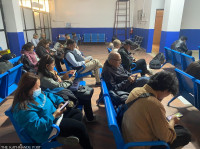Money
Congestion plagues Sirsiya Dry Port
The congestion at Sirsiya Dry Port in Birgunj has resurfaced with a large number of containers piled up at the port as importers are reluctant to clear their cargo.
Shankar Acharya
The congestion at Sirsiya Dry Port in Birgunj has resurfaced with a large number of containers piled up at the port as importers are reluctant to clear their cargo.
By Saturday afternoon, there were more than 700 containers in the Inland Container Depot (ICD) yard—154 empty and 557 loaded containers waiting for their owners to clear the cargo.
Similarly, another 900 containers are currently on the way to the port.
According to Himalayan Terminals, operator of the ICD, 10 railway rakes carrying containers from Vishakhapatnam and Kolkata port of India have already left for the dry port.
Two of the rakes will reach the port by Sunday morning and remaining within a few days. If those rakes don’t return with the same number of empty containers, the ICD will be chocked with the containers.
“It has been a few months since we started facing this problem. Importers do not clear their cargo on time and railway rakes return back without containers,” said an officer of Himalayan Terminals.
“After the Finance Ministry directed the custom officials to check the reference prices of imported goods to prevent under-invoicing and boost customs revenue collection, the importers are delaying the clearance.”
Those who import the raw material in bulk are the ones delaying the cargo clearance, according to the Dhan Bahadur Baruwal, acting chief of Sirsiya Dry Port.
“The importers, particularly, of plastic grains, legumes and sponge iron are not clearing their goods on time,” said Baruwal. “It seems like they lack proper warehouse to store the raw material. Therefore, they are clearing the raw materials gradually as per their need.”
This congestion has made it difficult to manage cargo traffic at the dry port and created problems for other importers too. If this condition continues, the problem will become more severe in the days to come when the goods imported from the third country will be stuck at the Indian ports. Since the trade embargo imposed by India in 2015, the port has seen a gradual rise in trade.
Trade activities have been increasing every year and are expected to go up even more, according to traders. “The port is making record transaction of handing of cargo every passing year and it has strained the existing infrastructure.”
If more than 1,000 containers are stranded, it fills up the dry port. The clearance of goods is delayed in many occasions especially goods like construction materials that are regularly imported.




 13.12°C Kathmandu
13.12°C Kathmandu













